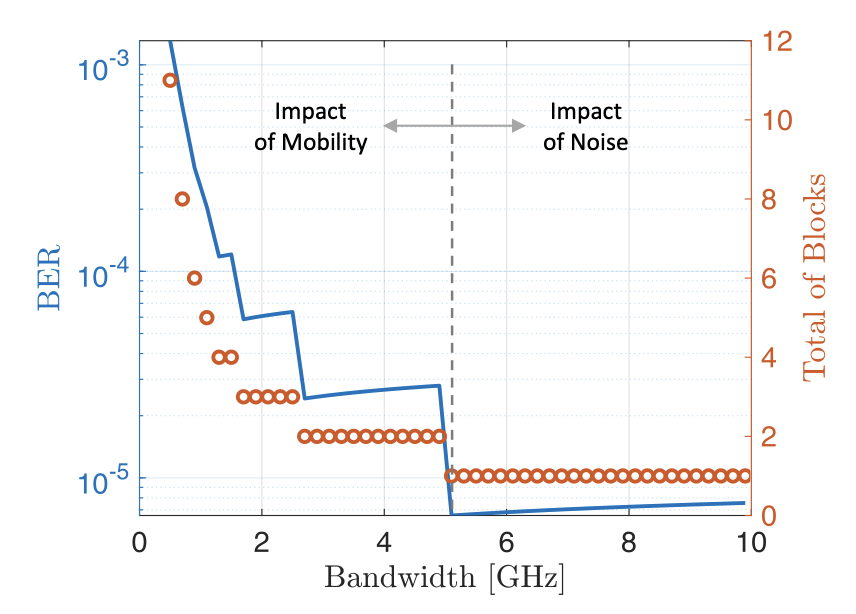Literature Database Entry
torres-gomez2022modeling
Jorge Torres Gómez, Anke Kuestner, Lukas Stratmann and Falko Dressler, "Modeling Ultrasonic Channels with Mobility for Gateway to In-Body Nanocommunication," Proceedings of IEEE Global Communications Conference (GLOBECOM 2022), Rio de Janeiro, Brazil, December 2022, pp. 4535–4540.
Abstract
Ultrasonic communication is one of the frequently discussed communication technologies for connecting in-body nanosensors with out-of-body gateway systems. Such communication has even been explored in various experimental setups. Yet, the impact of mobility remains mostly unexplored. This paper aims to fill this gap by studying the impact of mobility on ultrasonic communication channels. We study both Doppler shift as well as signal gain both in an analytical model as well as in an extensive set of simulations. Our results indicate a significant impact of the Doppler shift that needs to be compensated for real communication. We also show that the position of the nanosensors with respect to the gateway plays a very important role. Thus, we open the path for new research on protocol design for in-body to out-of-body communication using ultrasound.
Quick access
Original Version ![]() (at publishers web site)
(at publishers web site)
Authors' Version ![]() (PDF on this web site)
(PDF on this web site)
BibTeX ![]()
Contact
Jorge Torres Gómez
Anke Kuestner
Lukas Stratmann
Falko Dressler
BibTeX reference
@inproceedings{torres-gomez2022modeling,
author = {Torres G{\'{o}}mez, Jorge and Kuestner, Anke and Stratmann, Lukas and Dressler, Falko},
doi = {10.1109/GLOBECOM48099.2022.10000616},
title = {{Modeling Ultrasonic Channels with Mobility for Gateway to In-Body Nanocommunication}},
pages = {4535--4540},
publisher = {IEEE},
isbn = {978-1-66543-540-6},
address = {Rio de Janeiro, Brazil},
booktitle = {IEEE Global Communications Conference (GLOBECOM 2022)},
month = {12},
year = {2022},
}
Copyright notice
Links to final or draft versions of papers are presented here to ensure timely dissemination of scholarly and technical work. Copyright and all rights therein are retained by authors or by other copyright holders. All persons copying this information are expected to adhere to the terms and constraints invoked by each author's copyright. In most cases, these works may not be reposted or distributed for commercial purposes without the explicit permission of the copyright holder.
The following applies to all papers listed above that have IEEE copyrights: Personal use of this material is permitted. However, permission to reprint/republish this material for advertising or promotional purposes or for creating new collective works for resale or redistribution to servers or lists, or to reuse any copyrighted component of this work in other works must be obtained from the IEEE.
The following applies to all papers listed above that are in submission to IEEE conference/workshop proceedings or journals: This work has been submitted to the IEEE for possible publication. Copyright may be transferred without notice, after which this version may no longer be accessible.
The following applies to all papers listed above that have ACM copyrights: ACM COPYRIGHT NOTICE. Permission to make digital or hard copies of part or all of this work for personal or classroom use is granted without fee provided that copies are not made or distributed for profit or commercial advantage and that copies bear this notice and the full citation on the first page. Copyrights for components of this work owned by others than ACM must be honored. Abstracting with credit is permitted. To copy otherwise, to republish, to post on servers, or to redistribute to lists, requires prior specific permission and/or a fee. Request permissions from Publications Dept., ACM, Inc., fax +1 (212) 869-0481, or permissions@acm.org.
The following applies to all SpringerLink papers listed above that have Springer Science+Business Media copyrights: The original publication is available at www.springerlink.com.
This page was automatically generated using BibDB and bib2web.

